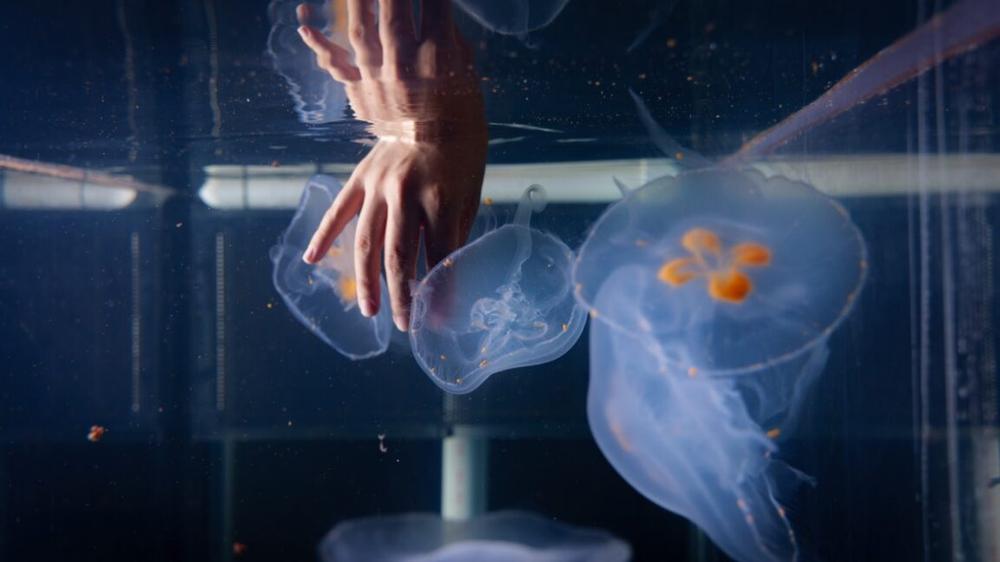Climate change is warming ocean waters, making the environment more acidic thanks to the absorption of carbon monoxide from the atmosphere. This endangers various marine species, and monitoring those changes is vitally important. But it can be challenging to reach the deepest waters without the aid of very expensive equipment. Moon jellyfish can swim to those depths, however, making them a potential ally in the quest to study the deep ocean.
That's why researchers at the University of Colorado at Boulder (CU Boulder) have built "cyborg" jellyfish equipped with tiny microelectronics devices, with the aim of gathering critical data on temperature, acidity, and other relevant properties. To further improve their hybrid creations, the team has been studying the biomechanics of how jellyfish swim. Their research also involves analyzing water flow patterns generated by swimming jellies using suspended starchy biodegradable particles, described in the group's most recent paper published in the journal Physical Review Fluids.
Creating biohybrid creatures is a well-established field. For instance, as we previously reported, scientists have been intrigued by the potential of cyborg insects since the 1990s, when researchers began implanting tiny electrodes into cockroach antennae and shocking them to direct their movements. The idea was to use them as hybrid robots for search-and-rescue applications.
In 2015, Texas A&M scientists found that implanting electrodes into a cockroach's ganglion (the neuron cluster that controls its front legs) was remarkably effective at successfully steering the roaches 60 percent of the time. They outfitted the roaches with tiny backpacks synced with a remote controller and administered shocks to disrupt the insect's balance, forcing it to move in the desired direction.
In 2021, scientists at Nanyang Technological University in Singapore turned Madagascar hissing cockroaches into cyborgs, implanting electrodes in sensory organs known as cerci that were then connected to tiny computers. Applying electrical current enabled them to steer the cockroaches successfully 94 percent of the time in simulated disaster scenes in the lab.
And earlier this year, Japanese scientists transformed cicadas into cyborg insects capable of "playing" Pachelbel's Canon. The idea is that cyborg cicadas might one day be used to transmit warning messages during emergencies. (You can listen to the sounds here.) They essentially hijacked the tymbals of male cicadas by attaching electrodes to create insect-computer hybrid speakers. A user interface sent electrical signals through an amplifier circuit and then on to the electrodes on the cicadas. Microphones recorded their chirps in response. Eventually, the team was able to induce the cicadas to produce specific musical notes over more than three octaves to "play" recognizable tunes.
Swimming with jellies
And now we have biohybrid moon jellyfish. Nicole Wu, an engineer at CU Boulder, built her first cyborg jellyfish in 2020, testing them in the shallow ocean waters off the coast of Woods Hole in Massachusetts. She describes the system as being akin to a pacemaker for the heart, electrically stimulating the jellies' swimming muscles to cause contractions, thereby steering them in a preferred direction. While moon jellies don't have brains or spinal cords, they do have rudimentary overlapping nerve nets that are well-suited to Wu's purposes.
"There's really something special about the way moon jellies swim," said Wu, describing them as one of the most energy-efficient animals on the planet. "We want to unlock that to create more energy-efficient, next-generation underwater vehicles."
Understanding the wakes and vortices that jellyfish produce as they swim is crucial, according to Wu, et al. Particle image velocimetry (PIV) is a vital tool for studying flow phenomena and biomechanical propulsion. PIV essentially tracks tiny tracer particles suspended in water by illuminating them with laser light. The technique usually relies on hollow glass spheres, polystyrene beads, aluminum flakes, or synthetic granules with special optical coatings to enhance the reflection of light.
These particles are readily available and have the right size and density for flow measurements, but they are very expensive, costing as much as $200 per pound in some cases. And they have associated health and environmental risks: glass microspheres can cause skin or eye irritation, for example, while it's not a good idea to inhale polystyrene beads or aluminum flakes. They are also not digestible by animals and can cause internal damage. Several biodegradable options have been proposed, such as yeast cells, milk, micro algae, and potato starch, which are readily available and cheap, costing as little as $2 per pound.
Wu thought starch particles were the most promising as biodegradable tracers and decided to study several different kinds of starches to identify the best candidate: specifically, corn starch, arrowroot starch, baking powder, jojoba beads, and walnut shell powder. Each type of particle was suspended in water tanks with moon jellyfish, tracking their movement with a PIV system. They evaluated their performance based on the particles' size, density, and laser-scattering properties.
Of the various candidates, corn starch and arrowroot starch proved best suited for PIV applications, thanks to their density and uniform size distribution, while arrowroot starch performed best when it came to laser scattering tests. But corn starch would be well-suited for applications that require larger tracer particles since it produced larger laser scattering dots in the experiments. Both candidates matched the performance of commonly used synthetic PIV tracer particles in terms of accurately visualizing flow structures resulting from the swimming jellyfish.
DOI: Physical Review Fluids, 2025. 10.1103/bg66-976x (About DOIs).

 Y Combinator says Apple’s App Store has hindered startup growth
Y Combinator says Apple’s App Store has hindered startup growth